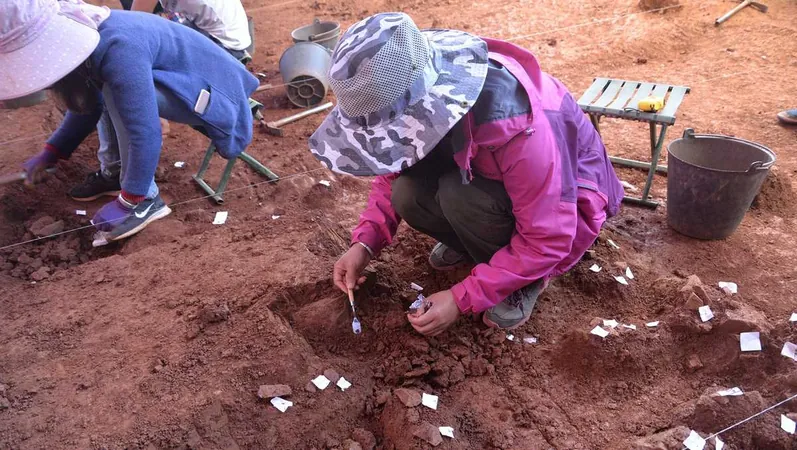
Shocking Discovery: Ancient Neanderthal Tools Unearthed in China!
2025-04-03
Author: Wei Ling
In an astonishing revelation, archaeologists have uncovered a treasure trove of stone tools in southwest China that may have been crafted by Neanderthals, a finding that could radically alter our understanding of human evolution. Excavations at the Longtan site in Yunnan province, close to the Tibetan Plateau, revealed hundreds of stone artifacts dating back approximately 60,000 to 50,000 years, crafted in a distinct style known as Quina, typically associated with Neanderthal culture.
The Quina Connection
This discovery is groundbreaking, as the Quina tool style has never been found in East Asia before, according to a study published in the Proceedings of the National Academy of Sciences. "The discovery at Longtan is remarkable," explained Davide Delpiano, a postdoctoral fellow in Paleolithic archaeology. "It documents this tradition far removed—up to 8,000 kilometers—from the area usually connected with this techno-cultural complex."
Neanderthals, a close relative of modern humans, thrived in Eurasia for around 400,000 years but mysteriously vanished around 40,000 years ago. Traditional records indicated that their remains were not found east of the Altai Mountains in southern Siberia. Yet, pieces of evidence from this excavation suggest they might have made it as far as China, or alternatively, that a different ancient human species could have created similar tools.
Tools for Survival in Harsh Climates
The tools found at Longtan include scrapers for working hides, stone points likely used for hunting, and notched tools resembling saws. The tool set is indicative of a highly mobile lifestyle adapted to exploit the resources of their cold and harsh environment. In Europe, similar Quina tools were utilized by Neanderthals during a similarly extreme climate 60,000 years ago, aiding in hunting activities among migrating herds of reindeer and horses.
Further analysis of ancient pollen from the site reveals that the climatic conditions in southwestern China at the time may have mirrored those of Europe, suggesting analogous ecological challenges. Despite the lack of animal remains at the site, researchers theorize that these early human inhabitants were adept at navigating their surroundings, indicating a sophisticated understanding of mobility in times of resource scarcity.
Two Competing Theories Shatter Preconceptions
The implications of this discovery have sparked intense debate among researchers. One theory posits that Neanderthals migrated eastward into China, while another suggests that a different yet contemporaneous species, possibly the Denisovans or an unknown hominin, might have independently developed similar tool-making skills in response to comparable environmental demands.
Previous fossils found in the Denisova Cave, where Neanderthals were discovered alongside Denisovans, hint at interactions between different human species. Some skulls in central China have also exhibited Neanderthal characteristics, raising questions about potential interbreeding and interaction across regions that have historically been viewed as isolated.
Is Early Human History Being Rewritten?
While the debate over who crafted these tools continues, the research highlights the importance of Asia in the narrative of human origins, challenging the long-held view that Eastern and Southeastern Asia were mere cultural backwaters. Ben Utting, an anthropologist at the Smithsonian, stresses that these findings underscore that human behavior in these regions was complex and dynamic, comparable to that of their Western counterparts.
As excitement surrounds this discovery, further excavation and research are essential to unravel the truths hidden in the soil of ancient Asia. The path toward understanding our ancestral lineage just got a lot more intriguing, and who knows what other discoveries lie dormant, waiting to be uncovered?
Stay tuned as this remarkable story unfolds, and explore theories about our past that could reshape the history of humankind as we know it!



 Brasil (PT)
Brasil (PT)
 Canada (EN)
Canada (EN)
 Chile (ES)
Chile (ES)
 Česko (CS)
Česko (CS)
 대한민국 (KO)
대한민국 (KO)
 España (ES)
España (ES)
 France (FR)
France (FR)
 Hong Kong (EN)
Hong Kong (EN)
 Italia (IT)
Italia (IT)
 日本 (JA)
日本 (JA)
 Magyarország (HU)
Magyarország (HU)
 Norge (NO)
Norge (NO)
 Polska (PL)
Polska (PL)
 Schweiz (DE)
Schweiz (DE)
 Singapore (EN)
Singapore (EN)
 Sverige (SV)
Sverige (SV)
 Suomi (FI)
Suomi (FI)
 Türkiye (TR)
Türkiye (TR)
 الإمارات العربية المتحدة (AR)
الإمارات العربية المتحدة (AR)